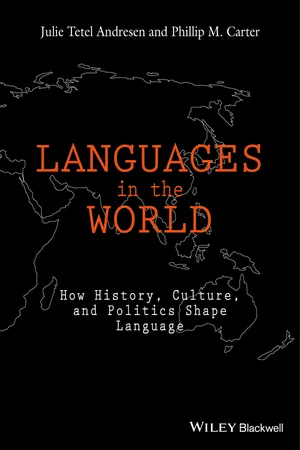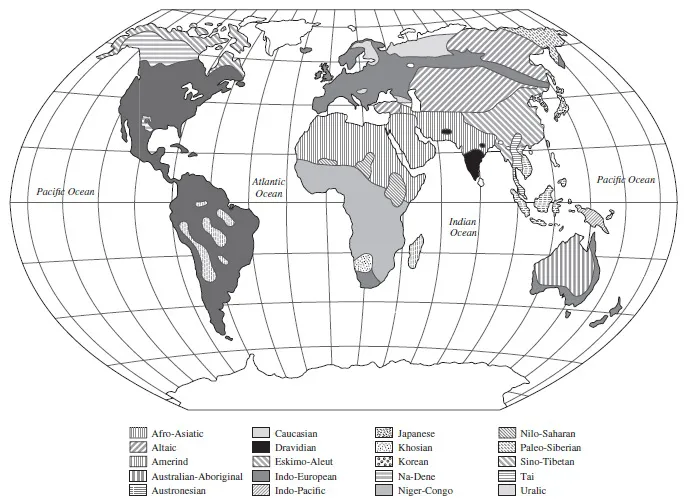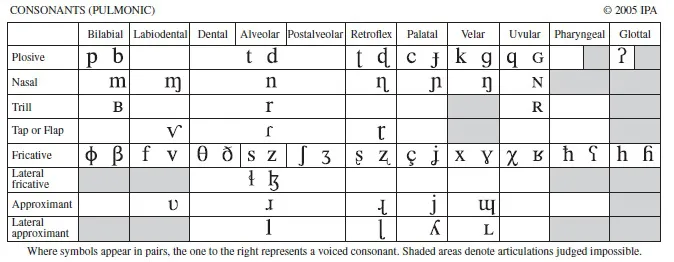
eBook - ePub
Languages In The World
How History, Culture, and Politics Shape Language
This is a test
- English
- ePUB (mobile friendly)
- Available on iOS & Android
eBook - ePub
Languages In The World
How History, Culture, and Politics Shape Language
Book details
Book preview
Table of contents
Citations
About This Book
This innovative introduction outlines the structure and distribution of the world's languages, charting their evolution over the past 200, 000 years.
- Balances linguistic analysis with socio-historical and political context, offering a cohesive picture of the relationship between language and society
- Provides an interdisciplinary introduction to the study of language by drawing not only on the diverse fields of linguistics (structural, linguist anthropology, historical, sociolinguistics), but also on history, biology, genetics, sociology, and more
- Includes nine detailed language profiles on Kurdish, Arabic, Tibetan, Hawaiian, Vietnamese, Tamil, !Xóõ (Taa), Mongolian, and Quiché
- A companion website offers a host of supplementary materials including, sound files, further exercises, and detailed introductory information for students new to linguistics
Frequently asked questions
At the moment all of our mobile-responsive ePub books are available to download via the app. Most of our PDFs are also available to download and we're working on making the final remaining ones downloadable now. Learn more here.
Both plans give you full access to the library and all of Perlego’s features. The only differences are the price and subscription period: With the annual plan you’ll save around 30% compared to 12 months on the monthly plan.
We are an online textbook subscription service, where you can get access to an entire online library for less than the price of a single book per month. With over 1 million books across 1000+ topics, we’ve got you covered! Learn more here.
Look out for the read-aloud symbol on your next book to see if you can listen to it. The read-aloud tool reads text aloud for you, highlighting the text as it is being read. You can pause it, speed it up and slow it down. Learn more here.
Yes, you can access Languages In The World by Julie Tetel Andresen, Phillip M. Carter in PDF and/or ePUB format, as well as other popular books in Languages & Linguistics & Linguistics. We have over one million books available in our catalogue for you to explore.
Information

Map 0.1 World map with language families. By PiMaster3 (own work) used under CC-BY-SA-3.0 (http://creativecommons.org/licenses/by-sa/3.0/), via Wikimedia Commons.

Figure 0.1 IPA consonants.

Figure 0.2 IPA vowels.
About the Website
Please visit the companion website at www.wiley.com/go/languagesintheworld to view additional content for this title.
- Short follow-up blurbs on one topic from each chapter
- Engaging links and images
Preface
To Our Readers
This book began with a simple phone call. In the Fall Semester of 2010, Julie was in Durham, North Carolina, where she is a Professor of Linguistics and Cultural Anthropology at Duke University. Phillip was living in Los Angeles, where he was a Postdoctoral Fellow in the Linguistics Department at the University of Southern California. We were on the phone to speak about the pleasures and challenges of teaching a course called Languages of the World. We found ourselves in familiar conversational territory: lamenting the lack of materials for teaching the course in the interdisciplinary approach developed at Duke. “Well,” Phillip said, “we could write our own book.” Julie laughed, imagining the amount of work required to pull together a project of the magnitude necessary to capture the dynamics of the pedagogical approach she had helped to create. But the seed had been planted. Only one question remained: Could we do it?
Beginning in the mid-1990s, Julie had been teaching Languages of the World taught at Duke, which was pioneered by Professor Edna Andrews in the Department of Slavic and Eurasian Studies. They wanted their students to have a broad understanding of language. Thus, they balanced the traditional content of such a course – review of the language families of the world, emphasis on linguistic structures, historical reconstruction – with the many rich nonlinguistic contexts in which languages are actually used. So, as students learned about the case and aspectual systems of Russian, for example, they also learned about the history of the Slavic language family, Cyrillic writing, Russian folk songs, and more. This approach required a great deal of work on the part of the instructor, since no materials systematically crossing linguistic structural information with historical, sociocultural, and political contexts existed in one place.
Over time, the course became a resounding success with students, not only among Linguistics Majors, for whom it is a core course requirement, but also with students from across the Arts and Sciences and even Engineering. The students came for what they heard would be a perspective-shifting and challenging experience. In retrospect, it is easy to understand why this course was so compelling to so many of our students. Our approach does not abstract language away from speakers, but rather situates it around them. It does not abandon experience and affect but makes space to acknowledge that experience and affect are fundamental to understanding why speakers make the choices they make about language. Simply put, students found themselves in the conversations the course made possible.
Once committed to writing our own materials Julie and Phillip agreed to meet in New York City in the Fall Semester 2011 when Julie was teaching the Duke in New York Arts and Media program. We went to work on a book proposal. The next summer, we found ourselves in a part of the world inspiring to both of us: Eastern Europe, with Julie in Romania and Phillip in Poland. We began to outline the book in Krakow, Poland where Phillip was attending Polish Language School, and we began writing the manuscript in Ukraine on a long train ride from Kiev to L'viv. Our research and writing continued nonstop for the next two and a half years, and our project went where we went: Bucharest, Romania; Durham, North Carolina; Los Angeles; Miami; Madrid, Spain; New York City; Saigon, Vietnam; Ulan Baatar, Mongolia.
During these years of writing, we have endeavored to stretch intellectually as far beyond our own experiences as possible. Nevertheless, our personal experiences are clearly reflected in the pages of our book. The most obvious example is that we have written about the languages we know and have studied, which include English, French, German, Mongolian, Polish, Portuguese, Romanian, Spanish, Swahili, and Vietnamese. In addition to being professional linguists, we are committed to language learning, and our knowledge of other languages has given us wide canvases to paint on. For instance, the Language Profiles on Vietnamese in Chapter 8 and Mongolian in Chapter 11 are the direct result of Julie's experience living and studying in Vietnam and Mongolia during the writing of this book.
We are also committed to interdisciplinarity, and our approach to linguistics is informed by a range of disciplines, all of which figure in Languages in the World: anthropology and anthropological linguistics, evolutionary theory, historical linguistics, history and philosophy of linguistics, genetics, language variation and change, poststructuralist approaches to critical theory, race and gender studies, and sociolinguistics. Our interdisciplinary commitment is reflected in our diverse intellectual interlocutors. Though you will not find explicit reference to all of the following names in our book, ripples of their thinking are nevertheless evident in our writing: anthropologist Stuart Hall; general scientists Jared Diamond, Charles Darwin, Francisco Varela, William James, and Humberto Maturana; historian Benedict Anderson; linguists (dialectologists, historical linguists, sociolinguists, and psycholinguists) Norman Faircloth, Charles Ferguson, Joshua Fishman, Joseph Greenberg, Jacob Grimm, Roman Jakobson, William Labov, Stephen Levinson, Johanna Nichols, Michael Silverstein, Michael Tomasello, Uriel and Max Weinreich, Walt Wolfram, and William Dwight Whitney; philosophers Judith Butler, Michel Foucault, Antonio Gramsci, Julia Kristéva, and Giyathri Spivak; and sociologists Pierre Bourdieu and Irving Goffman. All of these researchers share a general commitment to understanding the context, the situatedness, of humans in their psychosocial and sociopolitical worlds. In an effort to unburden our readers from excessive citations, we have tried to minimize references to these scholars throughout the book and acknowledge our debt to them here.
The familiar questions of a book addressing languages of the world are: What are the language families of the world? and What are the major structural characteristics of the languages in those families? These are, indeed, significant questions. We, too, want to address them here, and we also ask two more questions: Why does the current map of the languages of the world look the way it does? and How did it get to be that way? In order to answer these further questions, we need not only to broaden our perspective but also to create a new organizational framework. First, we acknowledge that the linguistic world goes around on the day-to-day interactions between individuals. Second, we see that the answers to the additional questions we are asking require our approach to focus less on the microdynamics of individual interactions and more on macroconcerns organized by the topics of power, movement, and time. Our extralinguistic attention in t...
Table of contents
- Cover
- Title page
- Copyright
- Map 0.1 World map with language families
- Figure 0.1 IPA consonants
- Figure 0.2 IPA vowels
- About the Website
- Preface
- Part I Linguistic Preliminaries
- Part II Effects of Power
- Part III Effects of Movement
- Part IV Effects of Time
- Glossary
- Subject Index
- Language Index
- EULA